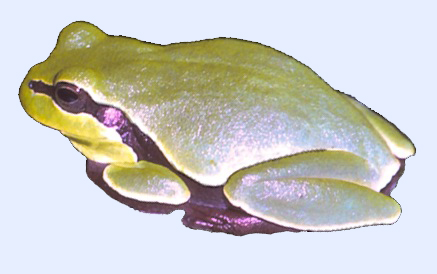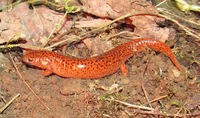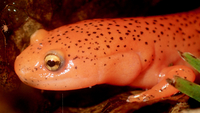Taxonomy
Class: AmphibiaOrder: CaudataFamily: PlethodontidaeSubfamily: Spelerpinae
Taxonomic Comments: The Red Salamander (Pseudotriton ruber ) is a relatively large, stout, reddish salamander with a short tail and short legs. This species can be found throughout a large portion of the eastern US, and taxonomists have traditionally recognized four largely allopatric subspecies. These are the Northern Red Salamander (P. r. ruber ) that is a large form with red or reddish orange above and prominent black spots, the Blue Ridge Red Salamander (P. r. nitidus ) which is similar but smaller, and with little or no spotting on the top of the posterior half of the tail, the Black-chinned Red Salamander (P. r. schencki ) that generally resembles P. r. ruber , but has heavy black flecking under the chin, and the Southern Red Salamander (P. r. vioscai ) that is generally duller colored than the other subspecies and often has a herringbone pattern on the back. The latter occurs on the Coastal Plain, while the others occur in upland areas in and around the Appalachian Mountains and adjoining Piedmont. P. ruber formed reciprocally monophyletic clades using either mitochondrial or nuclear DNA analyses and do not represent independently evolving lineages. The authors recommended continuing to recognize these subspecies for now, but many taxonomists would not do so since the morphologically defined subspecies do not closely parallel genetic patterns of variation across the range of this species. North Carolina has three of the four recognized subspecies. Here we provide range maps showing the approximate distributions of these in the state as suggested by Folt et al. (2016), but treat all in the species account below as P. ruber without recognizing subspecies.Species Comments:
Identification
Description: The Red Salamander is a relatively large, stout salamander with a short tail and short legs. The tail of adults averages about 38% of the TL, and the eyes are yellow except in Coastal Plain forms in the southern portion of the range (Petranka 1998). The dorsum and sides of the body vary from purplish brown to bright crimson red and are heavily marked with irregularly rounded black spots. The belly varies from pinkish to red and contains scattered black spots in the adults. The ventral black spots are sometimes absent in juveniles and young adults. In most areas of the range small juveniles and young adults are bright crimson red and boldly marked with black spots. Individuals darken with age and old adults are often purplish brown with fused black spots that are less distinct (Petranka 1998). Coastal Plain populations from throughout the range are duller overall. Individuals from our Piedmont populations also tend to be less brightly colored than those from the mountains. In general, individuals cannot be readily sexed using external morphology. The adults vary from 9.5-18 cm TL and there are 16 or 17 costal grooves. Bruce (1978a) found that females averaged about 10% larger than males in southern Blue Ridge populations. P. ruber resemble the Mud Salamander (P. montanus ), but the latter has brown eyes and fewer dorsal spots that are widely spaced, more rounded, and that rarely overlap. In contrast, all P. ruber in North Carolina have yellow eyes and much denser black spotting on the back. The spots tend to be more irregular in shaped and often overlap and partially fuse. Online Photos: Google iNaturalist Observation Methods: The larvae can be found by dip-netting or searching cover in small headwater streams and seepages. The adults are commonly encountered crossing roads during rainy nights during the fall and spring months as they disperse to and from overwintering and breeding sites. They can also be found beneath surface cover during warm weather. AmphibiaWeb Account
Distribution in North Carolina
Distribution Comments: The Red Salamander occurs from southern New York southwestward to western Kentucky and western Tennessee and southward to the Florida Panhandle and the Gulf Coast of Alabama, Mississippi, and extreme eastern Louisiana. This species is found east of the Mississippi River and is absent from most of the Atlantic Coastal Plain from Virginia southward to eastern Florida. Populations occurs at elevations ranging from near sea level to greater than 1500 m (4921'), but are relatively uncommon above 1200 m (3937'). In North Carolina, P. ruber is common and widespread in the mountains, but less so in the Piedmont. It is known from only a few localities in the Coastal Plain (Beane et al. 2010). Distribution Reference: Beane et al. (2010); Petranka (1998)County Map: Clicking on a county returns the records for the species in that county.
GBIF Global Distribution
Key Habitat Requirements
Habitat: Populations are most commonly found in hardwood forests with a perennial source of running water. The larval period last for more than a year and breeding sites such as small headwater streams, seepages, springs, and spring-fed bogs that hold water year-round and lack predatory fish are ideal. In karst regions females sometimes breed underground in caves (Miller et al. 2008). Larvae have also occasionally been found in standing water habitats such as woodland pools and beaver ponds (Bruce 2003). This species is rarely associated with large, swift-flowing streams, but larvae have sometimes been found in higher-order streams in leaf mats or other cover along the edges of large pools. These likely reflect the downstream drift of small larvae from headwater streams and springs where breeding occurs. Adults and juveniles are often locally abundant in or near thick accumulations of leaf litter in streams, particularly during the cooler months of the year. Many individuals leave the immediate vicinity of breeding sites and moved into the surrounding forests during the warmer months of the year. Sites with plenty of surface cover such as slabs of bark, rotting logs, and rocks provide ideal microhabitats for the juveniles and adults. Individuals have occasionally been found in meadows and pastureland that adjoins breeding sites, but these do not appear to be the preferred habitats and likely reflect individuals that are migrating to and from streams. Biotic Relationships: The natural predators are poorly documented but probably include crayfishes, fishes, woodland birds, snakes, shrews, raccoons, skunks, and the Spring Salamander (Petranka 1998). When pinched or prodded, the juveniles and adults usually assume a defensive posture which involves curling the body, elevating and extending the rear limbs, and placing the head in a protective position under the tail. While in this position, the tail is usually elevated and undulated slowly from side to side (Petranka 1998). Pseudotriton ruber has been the subject of numerous evolutionary studies that have tried to explain geographic variation in coloration (see Petranka (1998) for a comprehensive review). The terrestrial red eft stage of the Eastern Newt (Notophthalmus viridescens ) produces a powerful neurotoxin in the skin that is an effective chemical defense against predators. The bright crimson color of the efts serves as warning coloration and enhances a predator's ability to learn to avoid efts after an initial attack. Howard and Brodie (1971, 1973) hypothesized that P. ruber is a palatable Batesian mimic of Notophthalmus , and that avian predators are the primary agents selecting for the mimicry complex. A series of studies by these and other authors in the early 1970's provided strong support for the Batesian mimicry hypothesis. Both wild and domestic birds, for example, could be conditioned to avoid Red Salamanders after being exposed to red efts (Petranka 1998). The Mud Salamander (P. montanus ) and Spring Salamander (Gyrinophilus porphyriticus ) were also hypothesized to be a Batesian mimics of red efts for similar reasons.Notophthalmus and P. ruber . Both the red efts of Notophthalmus and P. ruber are brightly colored in montane areas where efts are abundant and diurnally active, but duller colored in non-mountainous areas where efts are rarely active during the day. These authors hypothesized that this pattern reflects selection for the mimicry complex in mountainous areas such as western North Carolina, and selection for cryptic coloration in regions where efts are uncommon and secretive during the day such as in Coastal Plain populations. P. ruber and P. montanus produce highly toxic skin secretions that are concentrated on the back skin. These researchers concluded that P. ruber and P. montanus are not Batesian mimics of red efts since they have reduced palatabilities of their own that are reinforced by skin color and defensive posturing. Currently, both of our Pseudotriton species are considered to be part of a Mullerian mimicry complex in which all members are unpalatable and benefit by evolving similar warning coloration.
Life History and Autecology
Breeding and Courtship: The breeding season is geographically variable and -- depending on the location -- can occur at almost any time of the year except during the coldest months (Petranka 1998). Adults in Virginia and Maryland populations mate primarily during the autumn and spring months (Organ and Organ 1968), while those in southern Blue Ridge populations in North Carolina mate primarily during the summer. Males in this region have sperm-filled vasa deferentia from mid-June through September (Bruce 1978a). Most adults breed annually. The ratio of males to females in samples taken by Bruce (1978a) was 1.89 which suggests that males may potentially compete for mates. Organ and Organ (1968) observed courtship of individuals from southwestern Virginia in the lab in June. The following description from Petranka (1998) is a summary of the major elements of courtship. P. ruber appears to be less complex than that of other plethodontids. In particular, the length of the tail-straddle walk appears to be much briefer in this species compared with other plethodontids. The authors' observations were made in small glass bowls which may have altered normal behavior such as the duration of the tail-straddle walk. Additional studies are needed to confirm their findings. Reproductive Mode: The females appear to be capable of long-term sperm storage and often lay eggs several months after courting. Females in most populations oviposit from late-summer through early winter in springs, headwater streams, seepage-fed mountain bogs, caves, and other suitable breeding sites that hold water year-round (Bishop 1941, Bruce 1972a, 1978a, Semlitsch 1983a). The nests have rarely been found which implies that most females oviposit in cryptic sites deep within seepages, springs or streambanks (Petranka 1998). Miller et al. (2008) found six egg clutches with attending females deep within in a cave in eastern Tennessee. They documented several other records of populations being associated with caves, which suggests that females often use caves with perennial underground water flow as breeding sites. Aquatic Life History: The hatchlings and older larvae reside in slow-moving sections of springs, seepages, and stream pools where decaying leaves, bottom debris, and aquatic plants provide cover and foraging sites (Petranka 1998). Cecala et al. (2007) documented the prey of larvae in three streams in the western Piedmont of North Carolina. The larvae consumed a wide variety of prey, particularly midges and fingernail clams. Numerous other prey were taken in small numbers, including insects such as mayflies, stoneflies, caddisflies, craneflies and beetles. Other prey included crayfishes, earthworms, leeches, isopods, copepods, amphipods and other invertebrates. On rare occasion, other salamander larvae were taken. In general, larvae consumed a greater diversity of prey items as they aged, and the consumption of prey decreased during the warmer summer months. Miller (2020) observed larvae feeding on the eggs of a Southern Two-lined Salamander (Eurycea cirrigera ) in Tennessee.Terrestrial Life History: Because the larvae transform at a relatively large size the juvenile stage is brief. Most males studied by Bruce (1978a) in the southern Appalachians sexually matured within 1 year after metamorphosing and bred during their fourth summer when nearly 4 years old. A few males required an additional year before mating for the first time. The males matured sexually when 53-63 mm SVL and the females when 55-68 mm SVL. Most females laid eggs for the first time when about 5-years old or older, then reproduced annually thereafter. Bruce (1978a) found that the sex ratio of juveniles was near 1:1, but that the number of mature males greatly outnumbered the number of mature females. Plethodon cinereus (Petranka 1998). Documented dietary items include a variety of insects, as well as earthworms, snails, slugs, spiders and millipedes.
General Ecology
Community Ecology: Red Salamander larvae often share aquatic habitats with Spring Salamander larvae. Gustafson (1993) conducted experiments in artificial streams to test for the impacts of intraguild predation among three species of larval plethodontid salamanders (Gyrinophilus porphyriticus , Pseudotriton ruber , and Eurycea cirrigera ). Large G. porphyriticus and large P. ruber larvae significantly decreased the survival of small P. ruber larvae, presumably through direct predation and cannibalism. There was a trend toward reduced growth of Pseudotriton and Eurycea in the presence of these intraguild predators. The presence of large Gyrinophilus also significantly reduced the growth rate of large Pseudotriton , both in the absence and presence of intraguild prey. These results suggest that intraguild predation may be an important force shaping salamander communities in headwater streams. The extent to which these results apply to natural systems needs to be investigated further.
Adverse Environmental Impacts
Habitat Loss: Countless local populations of the Red Salamander have undoubtedly been lost historically due to urbanization, deforestation, and the conversion of lands to agricultural fields following European colonization. Mountaintop removal has severely impacted salamander communities in coal-mining areas of Appalachia since this often results in the complete or partial burial of low-order streams by valley filling. Price et al. (2015) noted that ~1900 km of headwater streams in Central Appalachia were likely destroyed by valley filling that was allowed via permits. In addition to breeding sites being outright destroyed by burial, downstream areas in these and other surface coal-mining operations are also degraded from siltation, acidification, and the leaching of toxic chemicals. Stream-breeding salamanders that inhabit impacted areas have been adversely affected, along with stream invertebrates that serve as their food resources (e.g., Hutton et al. 2020, Price et al. 2015, Schorr et al. 2013). Habitat Fragmentation: Stream channelization, stream pollution, and excessive siltation have impacted many populations in fragmented landscapes with a matrix of urban areas, farmland, and bottomland forest remnants.
Status in North Carolina
NHP State Rank: S5Global Rank: G5Environmental Threats: In North Carolina, local populations of P. ruber and other stream-breeding salamanders in the lower valleys of the mountains and in many areas of the Piedmont have been eliminated or greatly reduced in numbers due to factors such as deforestation, urbanization, row-cropping, stream channelization and stream pollution and siltation. Surasinghe and Baldwin (2014) found that both current and historical land uses -- particularly timbering and row-crop agriculture -- have had lasting impacts on the local diversity of salamander species that occur in the Piedmont and Blue Ridge. In the Piedmont, lands that were intensely row-cropped many decades ago and have since become reforested still have low salamander diversity. Willson and Dorcas (2003) found that current land use is also affecting salamander abundance in Piedmont streams, and that the relative abundance of salamanders was strongly inversely proportional to the percentage of disturbed habitat in watersheds. They noted that the practice of establishing forested buffer zones along streams is not effective in conserving stream salamander populations in small riparian ecosystems that are embedded within landscapes with high human use.
Photo Gallery for Pseudotriton ruber - Red Salamander 22 photos are shown. Recorded by: Emily Stanley Recorded by: Jude Urfer Recorded by: Jude Urfer Recorded by: Jude Urfer Recorded by: Emily Stanley Recorded by: Andrew W. Jones Recorded by: Andrew W. Jones Recorded by: Andrew W. Jones Recorded by: Andrew W. Jones Recorded by: Andrew W. Jones Recorded by: Andrew W. Jones Recorded by: tom ward Recorded by: tom ward Recorded by: tom ward Recorded by: B. Bockhahn Recorded by: A. Lasley, E. Fite Recorded by: K. Bischof Recorded by: Steve Hall Recorded by: Owen McConnell & Jacob Perry Recorded by: Joe Mickey Recorded by: Jim Petranka Recorded by: Steve Hall and Dawson Sather

 »
»




 »
»


